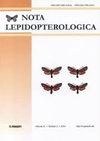帝王蝶(林奈,1758)及其寄主植物在葡萄牙大陆、亚速尔群岛和马德拉岛的殖民历史和最新分布
IF 0.7
4区 农林科学
Q4 ENTOMOLOGY
引用次数: 0
摘要
在伊比利亚第一次观察到黑脉金斑蝶(Danaus plexippus)可以追溯到1886年,尽管繁殖记录在近一个世纪后才出现:1960年在西班牙,20世纪80年代至90年代在马德拉和亚速尔群岛,2003年在葡萄牙大陆。本文回顾了黑脉金斑蝶及其寄主植物(Gomphocarpus fruticosus, G. physocarpus和Asclepias curassavica)在葡萄牙大陆和岛屿上的殖民历史。我们还汇编了现有的历史和最近的发生记录,作为全国范围内蝴蝶和寄主植物调查的基础,以更新它们在葡萄牙的当前分布。只有少数较旧记录的地点代表实地重新发现的种群,尽管最近出现的种群经常得到证实。在葡萄牙大陆的北部和中部,寄主植物很少,君主也没有,但在西南部,这两种植物都很常见。在马德拉岛,寄主植物在两个地方被发现,而君主是常见和广泛的。在亚速尔群岛,在七个被调查的岛屿中,有四个岛上观察到小的寄主植物斑块,而君主则很罕见,仅限于两个岛屿。在葡萄牙,废弃或半废弃的橘园是蝴蝶的大本营,在河流和道路边缘,寄主植物正在减少,这种蝴蝶越来越稀少。寄主植物的持久性是不稳定的,许多斑块被移除,而其他寄主植物已经扩展或殖民了新的区域。总的来说,寄主植物似乎正在减少,这意味着黑脉金斑蝶在该国的持续存在。本文章由计算机程序翻译,如有差异,请以英文原文为准。
History of colonisation and updated distribution of the Monarch butterfly Danaus plexippus (Linnaeus, 1758) and its hostplants in mainland Portugal, Azores and Madeira
The first observations of the Monarch butterfly (Danaus plexippus) in Iberia date from 1886, although breeding records emerged almost a century later: 1960 in Spain, 1980s–1990s in Madeira and Azores, and 2003 in mainland Portugal. We reviewed the history of the colonisation of mainland and insular Portugal by the Monarch butterfly and its hostplants (Gomphocarpus fruticosus, G. physocarpus and Asclepias curassavica). We also compiled available historical and recent occurrence records as a basis for countrywide surveys of the butterfly and hostplants, to update their current distributions in Portugal. Locations for only a few of the older records represented newly rediscovered populations in the field, although recent occurrences were often confirmed. Hostplants were scarce and monarchs absent in northern and central mainland Portugal, but both were quite common in the southwest. In Madeira, hostplants were found in two locations, while monarchs were common and widespread. In the Azores, small hostplant patches were observed on four of seven surveyed islands, whereas monarchs were rare and restricted to two islands. Abandoned/semi-abandoned orange orchards represent the butterfly’s stronghold in Portugal, with the species being increasingly scarce along rivers and road verges where hostplants are declining. Hostplant persistence is unstable, with many patches removed, while others have expanded or colonised new areas. Overall, hostplants appear to be declining, with implications for the persistence of monarch butterflies in the country.
求助全文
通过发布文献求助,成功后即可免费获取论文全文。
去求助
来源期刊

Nota Lepidopterologica
Agricultural and Biological Sciences-Insect Science
CiteScore
1.70
自引率
14.30%
发文量
20
审稿时长
14 weeks
期刊介绍:
Nota Lepidopterologica is the scientific, peer-reviewed journal of the Societas Europaea Lepidopterologica (SEL). It publishes original contributions to the study of mainly but not exclusively Palaearctic Lepidoptera, especially on taxonomy, morphology/anatomy, phylogenetics, biogeography, ecology, behaviour, and conservation, but also on any other aspects of lepidopterology.
All articles are published in English, with the possibility of having the summary written in other languages. All submitted manuscripts are subject to peer-review by the leading specialists for the respective topic. The journal is published in open access high-resolution PDF, semantically enriched HTML and machine-readable XML versions.
All papers can be freely copied, downloaded, printed and distributed at no charge. Authors and readers are thus encouraged to post the pdf files of published papers on homepages or elsewhere to expedite distribution. Publication is free for the SEL members and there is no charge for color.
 求助内容:
求助内容: 应助结果提醒方式:
应助结果提醒方式:


